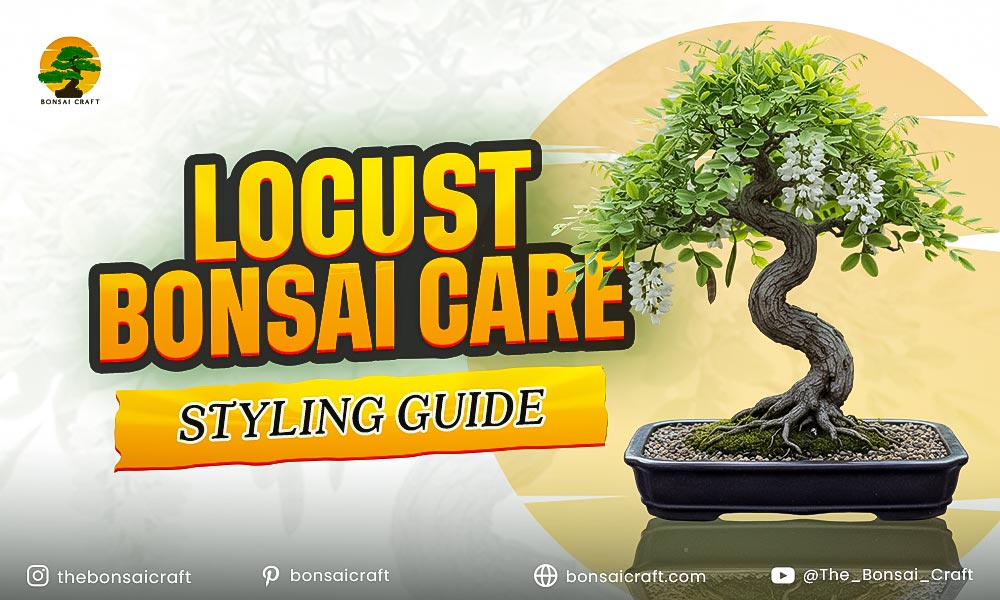
The art of bonsai is about transforming ordinary trees into living works of art, and the locust bonsai whether a honey locust bonsai (Gleditsia triacanthos) or a black locust bonsai tree (Robinia pseudoacacia) offers one of the most unique opportunities for growers. These species combine rugged bark, fine compound leaves, and strong resilience, making them excellent for both beginners and experienced bonsai enthusiasts.
With over a decade of bonsai cultivation experience, I’ve trained multiple bonsai locust trees from seedlings to mature styled specimens. This guide provides expert, trustworthy, and practical insights into locust bonsai care, styling, and long-term maintenance. Whether you want to start a locust bonsai from seed or refine a mature tree, you’ll find everything you need here.
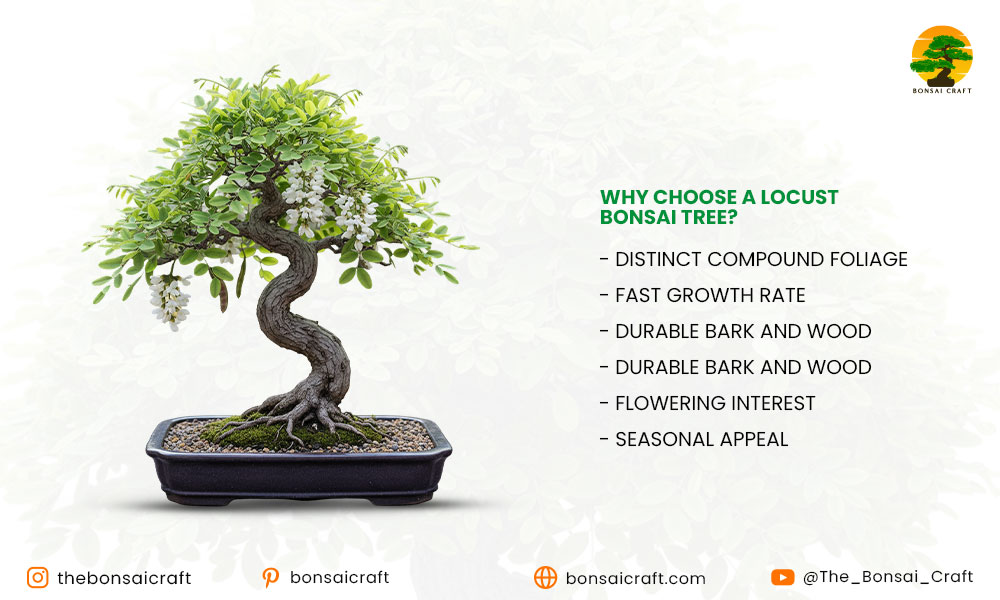
Why Choose a Locust Bonsai Tree?
The locust tree bonsai is highly versatile and attractive:
- Distinct compound foliage: Small leaflets naturally reduce, ideal for bonsai scale.
- Fast growth rate: Perfect for training and shaping into different bonsai styles.
- Durable bark and wood: Adds character and strength to older trees.
- Flowering interest: Black locust produces fragrant white blossoms in spring.
- Seasonal appeal: Honey locust shines with golden fall foliage and slender seed pods.
Both black locust bonsai and honey locust bonsai tree species are hardy, adaptive, and visually striking—an ideal blend for bonsai artistry.
Locust Bonsai Care Basics
To properly care for a locust bonsai, make sure to address watering, soil, pruning, and of course the seasonal requirements.
Sunlight
- Full sun for 6 to 8 hours a day promotes compact growth and diminutive leaves.
- Both black locust and honey locust bonsai trees benefit from strong sunlight to thrive, so place your tree in a sunny location, ideally south-facing.
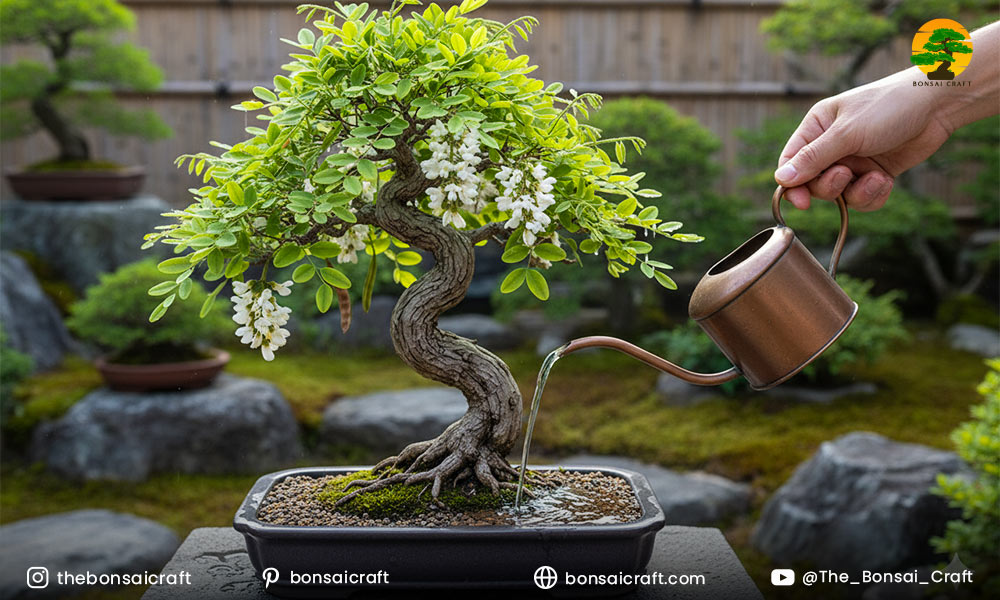
Watering
- The soil should be kept slightly moist.
- Honey locust requires more consistent moisture, while black locust bonsai tolerates occasional dryness.
- Water when the top layer of soil feels dry, but be sure to not let the roots sit in water.
Soil
- A free-draining bonsai mix with akadama, pumice, and lava rock ensures root health and prevents waterlogging.
- Locust trees dislike heavy, compact soil, so choose a substrate that promotes root development, nutrient absorption, and resistance to fungal diseases.
- Organic matter like pine bark helps retain moisture, particularly for honey locust bonsai in warmer climates.
Fertilizer
- Apply balanced liquid fertilizer every 2–3 weeks during the spring and summer.
- Avoid high-nitrogen fertilizers as they can lead to excessive leaf growth at the expense of the bonsai’s structure.
Temperature
- Locust trees are hardy but require winter protection in zones colder than USDA Zone 4.
- Consider storing your tree in a cold frame or a sheltered spot to shield it from freezing temperatures.
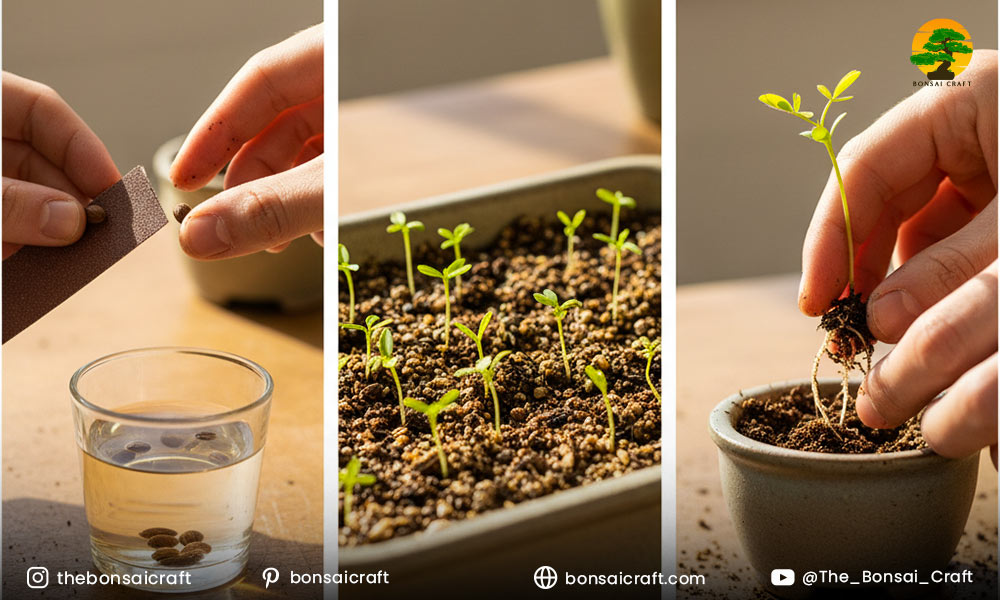
How to Grow a Locust Bonsai from Seed?
To grow a locust bonsai from seed, scarify the seed coat, soak the seeds in warm water, and plant them in a well-draining soil mix. Germination takes 2–4 weeks, and seedlings can be trained once they develop strong roots and branches.
Step-by-Step Guide:
- Scarify the seeds by lightly sanding or nicking the hard coat to enhance water absorption.
- Soak in warm water for 24 hours to encourage germination.
- Plant in bonsai soil, 1 inch deep, ensuring a well-draining mix.
- Maintain warmth (65–75°F) and moisture for sprouting.
- After 3–4 inches of growth, transplant seedlings into training pots.
- Start basic wiring and pruning in the second year to shape the tree.
What Is the Best Soil for Locust Tree Bonsai?
The best soil for locust bonsai care is a well-draining mix of akadama, pumice, and lava rock in equal parts. This blend prevents root rot, supports aeration, and holds enough moisture for healthy growth.
- Avoid heavy soils: Locusts dislike heavy, compact soil.
- Bonsai-specific substrates improve:
- Root development
- Nutrient absorption
- Resistance to fungal diseases
- For honey locust bonsai trees, adding pine bark can help retain moisture, especially in hot climates.
Locust Bonsai Styling Techniques
Training and styling a bonsai locust tree is where horticulture meets artistry. Here are some popular bonsai styles that suit locust trees:
Popular Bonsai Styles for Locust Trees:
- Formal upright (Chokkan): Ideal for black locust bonsai with strong trunks.
- Informal upright (Moyogi): Best for honey locust bonsai with flowing branches.
- Broom style (Hokidachi): Highlights the fine, airy foliage of honey locust.
- Literati (Bunjin): Suits tall, slender black locust specimens.
- Forest planting (Yose-ue): Multiple seedlings create a natural woodland effect.
Styling Tips:
- Use aluminum wire in spring when branches are most flexible.
- Pinch back new shoots to reduce leaf size and promote dense foliage.
- Avoid over-pruning in one season—locust trees are vigorous but sensitive to heavy cuts.
When and How to Repot a Locust Bonsai?
Repot a locust bonsai tree every 2–3 years (young trees) or 4–5 years (mature ones). The best time is early spring before new buds open. Trim up to one-third of the root mass and replace old soil with fresh bonsai mix.
Steps:
- Carefully remove the tree from the pot, checking for any root tangling.
- Use a root rake to untangle roots.
- Prune any and all thick and circling roots to promote growth.
- Use new bonsai soil and mix in a small amount of perlite for improved drainage.
- Wrap the tree in bonsai wiring for stabilization with the pot.
Locust Tree Bonsai Care Across Seasons
Caring for your locust bonsai tree varies by season:
- Spring: Repot, prune the tree heavily, and then fertilize the soil.
- Summer: Water midday to prevent leaves from wilting in the sun.
- Autumn: Cut back on feeding and enjoy the changing leaves along with the relaxing seed pods.
- Winter: Dry winter temps: Store in a cold frame or sheltered to protect from frost.
This cycle ensures healthy, year-round locust bonsai care.
Pests and Diseases in Locust Bonsai
Common issues:
- Aphids & scale insects: Sap-sucking pests causing leaf yellowing.
- Locust borer beetle: Weakens trunks and branches, particularly in black locust bonsai.
- Powdery mildew: White fungal growth on leaves.
Prevention & Treatment:
- Spray neem oil or horticultural soap for pests.
- Improve air circulation and avoid overwatering to reduce fungal risk.
- Inspect trees weekly during the growing season.
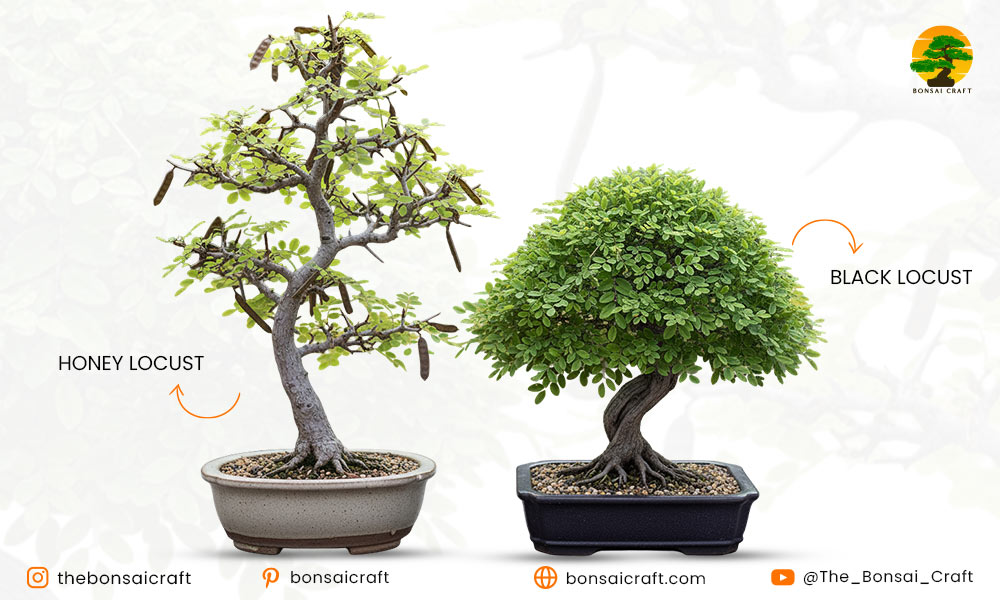
Black Locust Bonsai vs. Honey Locust Bonsai
| Feature | Black Locust Bonsai Tree | Honey Locust Bonsai Tree |
| Bark | Dark, rugged, deeply furrowed | Lighter, smoother |
| Leaves | Smaller, oval leaflets | Fine, fern-like foliage |
| Flowers | Fragrant white in spring | Inconspicuous |
| Growth Rate | Fast, vigorous | Moderate |
| Best Styles | Upright, literati | Broom, informal upright |
Advanced Tips for Locust Bonsai Styling
- Partial defoliation in summer reduces leaf size and promotes ramification.
- Jin & Shari Deadwood techniques emphasize the rugged black locust bark.
- Root-over-rock style works well as the locust roots grip strongly.
- To enhance the display, use accompanying moss or ferns.
Conclusion
The locust bonsai is a resilient, artistic, and highly rewarding tree for bonsai cultivation. Both honey locust bonsai trees and black locust bonsai trees offer unique aesthetics—whether you prefer fine, fern-like leaves or rugged bark with striking flowers. With patience, consistent care, and creative styling, your bonsai locust tree will evolve into a living masterpiece.
Expert Recommendation: If you’re a beginner, start with honey locust bonsai care for its manageable growth. Advanced growers seeking dramatic styling should explore the black locust bonsai tree for its bold bark and flowering character. Remember, bonsai cultivation is an ongoing journey, and each tree evolves in its own time.
FAQs About Locust Bonsai
Can you grow a locust bonsai from seed?
Yes. Locust bonsai from seed requires the scarification and soaking of seeds and then the seeds of scarified pods are placed into soil with good drainage. It takes a lot of time but with this method, you can bonsai from the seed.
How often should I water my locust bonsai tree?
A Locust bonsai tree should be watered with the top dry layer of soil technique. Since honey locusts love the moist, while the black bonsai can survive in almost dry conditions, try to find a happy medium. Do not overwater as you can cause root rot.
What fertilizer is best for locust bonsai care?
Best to use a balanced liquid bonsai every 3 weeks or so in Spring and Summer. For locust bonsai care, do not use the chemical fertilizer with the most nitrogen in it as it is not good for the branches, leaves and fragmentation.
Is the locust bonsai suitable for beginners?
Yes, locust honey bonsai trees and black locust bonsai trees are both very hardy and adaptable. They are forgiving if mistakes are made and their resilience makes them ideal starter species for bonsai learners.
How often should I repot a locust bonsai?
Young bonsai need repotting every 2 to 3 years and mature bonsai need repotting every 4 to 5 years. Repotting locust bonsai is best done in early spring to ensure the health of the root systems and to rejuvenate growth.
